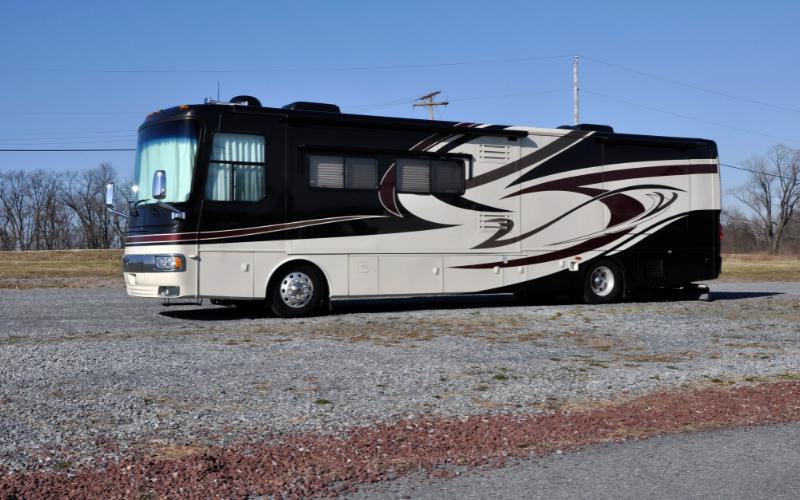What Is the Average Lifespan of an RV?

When you buy an RV, you’re investing in freedom, comfort, and adventure. But one of the biggest questions new and seasoned owners often ask is — how long does an RV really last?
The average lifespan of an RV depends on several factors like build quality, maintenance habits, storage conditions, and how often it’s used. While the short answer is around 20 years or 200,000 miles, that number can shift dramatically depending on care and usage.
In this guide, we’ll break down what affects the life expectancy of an RV, signs of aging, and how to make your RV last longer. This is your complete roadmap to getting the best return on your investment — straight from the experts at Popular RV, your trusted marketplace to buy and sell RVs online fast.
Understanding RV Lifespan
The lifespan of an RV is typically measured by years of use or mileage. On average, a well-maintained RV can last 15 to 20 years, or around 200,000 miles for motorized types. However, not all RVs are created equal. Some high-end models with strong chassis and premium components can easily exceed 25 years with proper care.
To understand RV longevity, you must consider three key factors:
-
Build quality: Premium materials and craftsmanship extend durability.
-
Maintenance: Regular cleaning, servicing, and repair work prevent early wear.
-
Usage patterns: Full-time travelers experience faster wear than seasonal users.
Average Lifespan by RV Type
Different types of RVs age differently. Let’s break it down:
1. Class A Motorhomes
These are the largest and most luxurious motorhomes on the market. Built on heavy-duty chassis, they can last 15–20 years or 200,000–300,000 miles with regular maintenance.
Why they last longer:
-
Strong diesel engines
-
High-quality frames
-
Better insulation and structure
Common lifespan threats:
-
Engine wear from long-distance travel
-
Roof leaks if not sealed regularly
2. Class B Motorhomes (Camper Vans)
Compact and efficient, these vans can go the distance. Class B motorhomes typically last 20 years or more, since they use commercial-grade van chassis designed for long life.
Longevity tips:
-
Maintain the van engine regularly
-
Keep the body clean to prevent rust
-
Use proper ventilation to reduce interior wear
3. Class C Motorhomes
Sitting between Class A and Class B in size, Class C RVs offer comfort and decent durability. Expect a 15–20 year lifespan or about 150,000–200,000 miles.
Factors that affect longevity:
-
Engine type (gas vs. diesel)
-
Roof condition (frequent water leaks reduce life)
-
Weight distribution and tire care
4. Travel Trailers
Travel trailers don’t have engines, which means fewer mechanical parts to wear out. They can last 20–25 years if properly maintained.
Lifespan factors:
-
Frame rust prevention
-
Tire rotation and brake maintenance
-
Proper storage (indoors or under a cover)
5. Fifth Wheels
Built for long-haul camping, fifth wheels often outlast traditional travel trailers due to their heavy-duty design. They can easily reach 25–30 years with consistent care.
Maintenance checklist:
-
Lubricate the hitch
-
Check slide-outs for seal damage
-
Inspect the undercarriage annually
What Affects the Lifespan of an RV?
Several external and internal factors play a huge role in how long your RV will last. Understanding them helps you avoid costly surprises down the road.
1. Maintenance Habits
Neglect is the biggest killer of RV lifespan. Regular maintenance keeps systems running smoothly and prevents small problems from turning into expensive repairs.
Key maintenance tasks:
-
Oil changes for motorhomes every 3,000–5,000 miles
-
Roof sealing every 6–12 months
-
Tire inspection before each trip
-
Water system cleaning every season
2. Storage Conditions
Where you store your RV when not in use matters more than most people think. Sun, rain, and humidity can damage both the exterior and interior.
Best practices:
-
Store in a covered or climate-controlled space
-
Use RV covers for UV protection
-
Keep windows slightly open to prevent mold buildup
3. Frequency of Use
Full-time RVers put more wear on systems like plumbing, HVAC, and suspension. The more you drive, the faster these parts age.
Tip: Even if you travel a lot, regular servicing and replacing worn parts can offset heavy use.
4. Build Quality and Brand
Higher-quality RVs are built to last. Brands using aluminum frames, fiberglass roofs, and marine-grade plywood offer greater resistance to time and weather.
Look for:
-
Solid wood cabinetry
-
Welded frames
-
High-grade insulation
-
Reputation for quality craftsmanship
5. Climate and Environment
RVs exposed to salt air, heavy snow, or extreme heat will wear down faster.
Example:
An RV stored in Long Beach, California — like at Popular RV | Buy and Sell RVs Online Fast — will generally last longer if it’s protected from coastal moisture and direct sun exposure.
Signs Your RV Is Nearing the End of Its Lifespan
Like any vehicle, RVs start to show aging signs. Watch for these common red flags:
-
Frequent leaks or water damage
-
Water is the number one cause of RV deterioration. Check roof seams, windows, and slide-outs often.
-
-
Rust and corrosion
-
Undercarriage rust is a big warning sign, especially for trailers and motorhomes in humid areas.
-
-
Electrical problems
-
Flickering lights, short circuits, or battery drain mean aging wiring.
-
-
Soft flooring or wall damage
-
Indicates water infiltration or structural weakening.
-
-
Poor insulation
-
If your RV feels unusually hot or cold, the insulation may be breaking down.
-
-
Engine or transmission wear (motorhomes)
-
Difficulty starting or shifting gears signals deeper mechanical issues.
-
How to Extend the Life of Your RV
Here’s the truth: with the right maintenance routine, you can double the lifespan of your RV. Follow these proven steps:
1. Wash and Wax Regularly
Dirt and grime wear down paint and seals. Clean your RV every few months and apply a good wax to protect from UV rays.
2. Inspect Roof and Seals Frequently
Water intrusion destroys RVs from the inside out. Inspect and reseal roof seams every six months.
3. Use Quality Replacement Parts
Cheap components fail faster. Always invest in OEM or reputable aftermarket parts.
4. Keep Tires in Top Shape
Tires carry heavy loads. Rotate and replace them every 5–7 years, even if the tread looks fine.
5. Flush Plumbing Systems
Sediment buildup can cause plumbing blockages. Clean tanks and pipes seasonally.
6. Protect the Interior
Use UV shades, clean upholstery, and control moisture to keep interiors fresh and damage-free.
7. Drive Smoothly
Avoid hard braking, sharp turns, or overloading the suspension system. Gentle driving habits go a long way.
8. Store It Right
A well-stored RV is a long-lasting RV. Cover it or keep it in a garage to prevent exposure damage.
RV Maintenance Schedule for Longevity
Here’s a simple checklist to keep your RV in great shape year-round:
| Frequency | Task |
|---|---|
| Every Trip | Check tire pressure, lights, and brakes |
| Monthly | Clean roof, check for leaks, inspect seals |
| Every 3 Months | Change oil, test generator, inspect battery |
| Every 6 Months | Lubricate moving parts, reseal roof edges |
| Annually | Full inspection of plumbing, brakes, and suspension |
| Every 2 Years | Replace tires, service HVAC, deep clean tanks |
Sticking to this schedule can easily add 5–10 years to your RV’s life.
When to Replace or Sell Your RV
Even with great care, every RV reaches a point where repairs outweigh value. Knowing when to let go is crucial.
It’s time to replace your RV when:
-
The repair costs exceed 50% of its resale value.
-
The frame or structure is weakened.
-
It fails major inspections repeatedly.
-
You’re spending more time in the shop than on the road.
When that time comes, you can easily sell your old RV or upgrade through Popular RV. Their platform allows you to buy and sell RVs online fast, connecting you with real buyers across California and beyond.
How Popular RV Helps You Extend Your RV Journey
At Popular RV | Buy and Sell RVs Online Fast, we understand the emotional and financial value behind every RV. Whether you’re buying your first motorhome or upgrading after 20 years, we help you make confident, informed decisions.
Why RV owners choose Popular RV:
-
Transparent listings with verified information
-
Easy-to-use online platform
-
Fast transactions and secure payments
-
Expert advice from seasoned RV enthusiasts
Located at 1923 E 7th St, Long Beach, California 90813, our team is always ready to guide you in choosing or selling the right RV to match your lifestyle.
Final Thoughts
The average lifespan of an RV depends on how well you treat it. While most last around 15–20 years, careful maintenance, smart storage, and mindful use can push that number much higher.
Think of your RV as a home on wheels — the better you care for it, the longer it takes you on unforgettable adventures.
And when you’re ready for your next upgrade, Popular RV is your go-to destination to buy and sell RVs online fast. With expert support, honest guidance, and nationwide reach, you’ll always find your next home-on-the-road in great condition.






